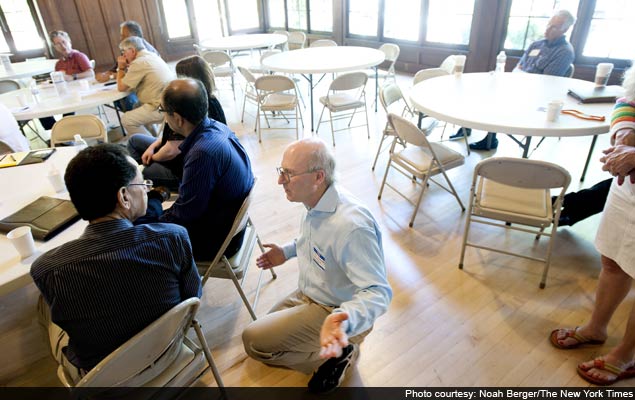- Home
- Laptops
- Laptops News
- The idled of Silicon Valley
The idled of Silicon Valley

Doernberg worked in chip design, before that industry shrank, and then for a solar energy company, before that industry shrank, and has been unemployed since the middle of last year. By his own account, his skills are not ideal for the current job market. Nor does it help, he says, that at 53, he looks older than he is; youth is at a premium in his industry. So, too, is optimism.
"It's a question of convincing someone that with these skills, I can do this job, even though I haven't done it before," he said. "I'm very optimistic. I know I will find a job."
The questions of skills, jobs and nationality are a combustible mix these days.
Silicon Valley companies, warning of an acute labor shortage, say it is too costly to retrain older workers like Doernberg, and that the country is not producing enough younger Americans with the precise skills the industry needs. Their arguments have persuaded a majority of senators to give them what they want: a provision in the immigration bill to let in many more foreign professionals.
But Americans like Doernberg and the powerful labor lobby say that what the tech industry really wants is to depress wages and bring in more pliant, less costly temporary workers from overseas. If there is such a talent shortage, they ask, why aren't wages for most engineers rising faster?
Labor groups have pushed for a requirement to offer jobs to equally qualified Americans before hiring foreigners, a provision that the industry fiercely resisted.
The pitched arguments of both sides, which are likely to resurface in the House when it takes up its version of an immigration overhaul, cloud a complicated reality. There is little empirical evidence to suggest that foreign engineers displace U.S. engineers as a whole.
If anything, one recent study suggests, the growth of immigrant workers in U.S. companies helps younger U.S. technical workers - more of them are hired and at higher-paying jobs - but has no noticeable consequences, good or bad, on older workers.
"In the short run, we don't find really any adverse or superpositive effect on the employment of Americans," said William R. Kerr, a Harvard business professor who conducted the study on the work force of 300 U.S. companies. "People take an extremely one-sided view of this stuff and dismiss any evidence to the contrary."
A recent analysis by the Brookings Institution reached a similar conclusion. It found that in the top 10 cities that bring in the largest number of high-skilled guest workers on H-1B visas, college-educated Americans - those who could compete for jobs with high-skilled guest workers - are not more likely to be unemployed.
At the same time, though, the industry's claims of a labor shortage may be somewhat overblown. Most H-1B workers hold entry-level positions. Economists say that bringing in more of these workers would serve to keep wages down. It also saves employers the trouble of having to retrain workers.
There is a difference between what companies say they need and want, said Peter Cappelli, a management professor at the Wharton School at the University of Pennsylvania. "Saying we need people with these skills is like me saying I need a four-wheel drive," he said. "They could retrain people."
It is true that for certain categories of engineers, wages are not going up as sharply as one would expect if good engineering talent were indeed hard to find. But it is also true that engineers with certain specialties, like software development, are hard to find.
Intel, for instance, which has more than 50,000 employees in the United States, said it has 1,000 openings. Motorola Solutions said it was scrambling for software engineers. And unemployment among technology professionals is generally about half the national average, buttressing the industry's claims.
Economists say there may be other reasons for opening the door to high-skilled immigrants. In cities where there are large concentrations of such immigrants in science and engineering, overall wages tend to go up, especially among college-educated U.S. residents, and eventually, so do housing prices, according to a study by Giovanni Peri, an economist at the University of California, Davis.
The Congressional Budget Office weighed in this week too, concluding that the growth in high-skilled immigration would lead to "slightly higher" productivity and in turn higher wages overall.
Already, the fight over high-skilled immigration has led to arguments and counterarguments on the Senate floor, with one side warning that jobs will flock overseas and the other rallying for Americans first.
But Ardine Williams, the vice president for human resources at Intel, said that hiring Americans is not always practical. Asked about hiring unemployed engineers in this country, she said, "I encounter those folks as well. They are skilled and have expertise outside of an area where we need engineers. In some cases they haven't kept their skills current."
The debate over the effect of foreign engineers on U.S. ones has obscured the critical issue of why more Americans are not going into the thriving technology sector. Students in the United States consistently rank low on global math and science tests, suggesting that relatively few are prepared to go into rigorous science and engineering programs.
In engineering programs at U.S. universities, a little more than 40 percent of all graduate students were from abroad, according to data from the National Science Foundation. Even among Americans who do graduate with computer science or engineering degrees, a third pursue careers outside the tech sector.
Doernberg is keeping his fingers crossed. A resident of Woodside, Calif., an upscale town south of San Francisco, he spends his days scouring online job boards and attending networking sessions at diners and church halls across Silicon Valley. One of them is a Thursday morning group that meets in a church in Saratoga, a short drive from his home.
It was set up years ago by Hamid Saadat, an electrical engineer who came to this country from Iran as a graduate student in 1978, worked at a series of semiconductor companies in the area, became a U.S. citizen and went through the same rite of passage as Doernberg.
In 2001, just as the technology industry slumped, he lost his job. He was 47 and he soon learned one lesson: In Silicon Valley, it may not matter where you were born, but when.
"As much as we like to believe there's no discrimination, being younger usually helps," Saadat said.
© 2013, The New York Times News Service
Catch the latest from the Consumer Electronics Show on Gadgets 360, at our CES 2026 hub.
Related Stories
- Samsung Galaxy Unpacked 2025
- ChatGPT
- Redmi Note 14 Pro+
- iPhone 16
- Apple Vision Pro
- Oneplus 12
- OnePlus Nord CE 3 Lite 5G
- iPhone 13
- Xiaomi 14 Pro
- Oppo Find N3
- Tecno Spark Go (2023)
- Realme V30
- Best Phones Under 25000
- Samsung Galaxy S24 Series
- Cryptocurrency
- iQoo 12
- Samsung Galaxy S24 Ultra
- Giottus
- Samsung Galaxy Z Flip 5
- Apple 'Scary Fast'
- Housefull 5
- GoPro Hero 12 Black Review
- Invincible Season 2
- JioGlass
- HD Ready TV
- Laptop Under 50000
- Smartwatch Under 10000
- Latest Mobile Phones
- Compare Phones
- OPPO Reno 15 Pro Max
- Honor Win RT
- Honor Win
- Xiaomi 17 Ultra Leica Edition
- Xiaomi 17 Ultra
- Huawei Nova 15
- Huawei Nova 15 Pro
- Huawei Nova 15 Ultra
- Asus ProArt P16
- MacBook Pro 14-inch (M5, 2025)
- OPPO Pad Air 5
- Huawei MatePad 11.5 (2026)
- Xiaomi Watch 5
- Huawei Watch 10th Anniversary Edition
- Acerpure Nitro Z Series 100-inch QLED TV
- Samsung 43 Inch LED Ultra HD (4K) Smart TV (UA43UE81AFULXL)
- Asus ROG Ally
- Nintendo Switch Lite
- Haier 1.6 Ton 5 Star Inverter Split AC (HSU19G-MZAID5BN-INV)
- Haier 1.6 Ton 5 Star Inverter Split AC (HSU19G-MZAIM5BN-INV)

















